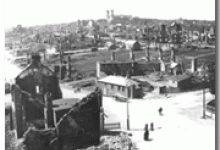City Name

Where St. John’s received its name is a mystery and is open to much dispute. There are several theories were the name came from.
A popular theory is that John Cabot named St. John’s as a result of visiting the port on St. Jean the Baptist Day - June 24th. But given the notion that Cabot supposedly made his landfall in Bonavista on that day, it seems a bit unlikely.
The most likely one is credited to Portuguese explorer Gaspar Corte-Real, who first visited Newfoundland in 1500. There is some validity in that the earliest record of the place name appears on a Portuguese map by Rienel, 1519, as Rio de San Johem. Corte-Real, or one of his contemporaries, paid a brief visit to the harbour, saw the distant Waterford River, and named it St. John’s River. Hence the ‘s in the name.
The name of St. John’s varied considerably during the sixteenth century. Some of the names which followed Rienel’s Rio de San Johem are: Haven of St. John (Rut, 1527); Sam Johem (Freire, 1546); Sainct Johan (Le Testu, 1555); St. John’s (Parkhurst, 1578; also Hayes, 1583); S. Jones (Velasco, 1610); Saint Johns (Mason, 1620); St. John’s (Whitbourne, 1588-1622); St. Ieans Harbour (Visscher, c. 1680); St. John’s Harbour (Thornton, 1689).
It appears that Parkhurst was the first person to record the common spelling. He was an English Merchant who made four voyages to Newfoundland in the 1570's.
There is also the possibility that the place was given its name by one of the early English mariners. Not far from where Cabot sailed from in England, is the Church of St. John the Baptist, known as St. John’s- on- the-Wall. It was built in 1174 and rebuilt in 1400 and was the last survivor of five churches that were in or on the old quay from the Church to Froom Gate, the dock used by Cabot and others who sailed to Newfoundland around 1500. Many of the sailors on those early vessels must have come from the British parish of St. John’s. The church was known to all of them. In some manner they may have named the popular port for their home parish.
Another theory comes from Judge G.R.F. Prowse, a noted historian. Prowse says that we know that Cabot called his landfall the Isle of St. John’s in commemoration of the feast day on which it was discovered. Based on his study, he concluded that the name St. John’s Isle became associated with an indefinite part of the east coast of Newfoundland. He says the name could have been short lived but also could have become associated with the harbour by sailors who used the harbour as their first and last port of call. Prowse maintains that it would have been known as the "harbour of St. John’s Island" which could account for the possessive form, St. John’s, instead of St. John.
Extracted from the book:
O’Neill, Paul. (1975). The Oldest City, The Story of St. John’s, Newfoundland. Erin, Ontario: Press Porcepic.
